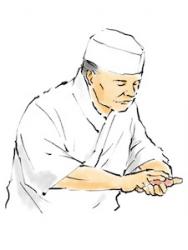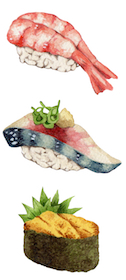世界中でもヘルシーフードとして人気の“我らが鮨”には、その起源から種類、食べ方まで日本人でも知らない“ネタ”がいっぱい。There is so much information about ‘our sushi’, popular as a healthy food worldwide, that even Japanese people may not know all the facts.

回ったり並べたり、握ったり巻いたり、今やメルボルンでもワンブロックに必ず1軒はある鮨ショップ。オーストラリアはもちろん、世界中でヘルシーフードとして人気の“我らが鮨”には、その起源から種類、食べ方まで日本人でも知らない“ネタ”がいっぱい。話の“ネタ”を仕込んで、鮨のネタもおいしく食べよう。
Whether it’s nigiri-zushi or nori rolls, rotating on a conveyer belt or lined up in a row, right now in Melbourne you’ll see a sushi shop on every block. There is so much information about ‘our sushi’, popular as a healthy food worldwide, that even Japanese people may not know all the facts. Enjoy these morsels of information, and you’ll enjoy your sushi all the more.
| ● ● ● 蘊蓄を少しだけ ● ● ● |
鮨の起源
東南アジアの山地民族の間で行われていた魚の貯蔵法で、米などの穀類と川魚を炊いたものを一緒に漬け込み、米の発酵を利用して魚を保存した。これが中国に渡り、朝鮮半 島を経由して奈良時代に日本に伝わると“馴れずし”と呼ばれるようになった。この流れを汲むのが滋賀県の琵琶湖で獲れた鮒を塩浸けにし、米飯を重ねて自然発酵させた“鮒ずし”。安土桃山時代になると酢の登場から飯ずしが誕生し、江戸時代後期に流行した屋台のなかから“にぎり鮨”が 生まれたとされる。これは、東京湾(=江戸の前=江戸前)でとれる魚介・海苔を使ったことから “江戸前鮨”と呼ばれるようになったといわれる。
寿司と鮓と鮨
一般的に使われている“寿司”は、“寿を司る”という縁起をかついだ当て字で、“すし”全般に使わ れている。“鮓”は魚を発酵させて作る保存食の意味があり“鮒鮓”“馴鮓”などの発酵系の“すし”に。 “鮨”は握る、型に入れる意味があるほか、魚が旨いという意味で作られた漢字という説もあり、“握り鮨”“箱鮨”などに使うとされている。
いろいろな種類
 にぎり鮨は、酢飯をひと口大に握り、わさびを塗った上に魚介類をのせたもの。イクラやウニな ど崩れ易いネタは、握った酢飯の周りを海苔で巻いた上に盛り付ける“軍艦巻き”で。海苔の上にご飯を敷き詰めてネタを乗せて巻き、適当な大きさに切り揃えたものが海苔巻き。桜でんぶや干 ぴょう、キュウリに玉子焼きなどたくさんの具材を巻き込んだ5cm以上の太さのものを太巻き、海産物をメインに数品を巻き込んだ中巻き、キュウリ、ネギトロ、干ぴょう、納豆などの単品ネタを巻き込んだ直径3cm程の細巻きがある。また、海苔が表面に来ないように裏返して巻くものを“裏巻 き”と呼ぶ。ちらし寿司は、寿司飯の上に海産物を“散らす”ことから呼ばれ 、押し寿司は、酢飯を握るのではなく、型にはめて“押し込む”ことによって作られる。一度に大きく作り、食べる時に切り分 ける。
にぎり鮨は、酢飯をひと口大に握り、わさびを塗った上に魚介類をのせたもの。イクラやウニな ど崩れ易いネタは、握った酢飯の周りを海苔で巻いた上に盛り付ける“軍艦巻き”で。海苔の上にご飯を敷き詰めてネタを乗せて巻き、適当な大きさに切り揃えたものが海苔巻き。桜でんぶや干 ぴょう、キュウリに玉子焼きなどたくさんの具材を巻き込んだ5cm以上の太さのものを太巻き、海産物をメインに数品を巻き込んだ中巻き、キュウリ、ネギトロ、干ぴょう、納豆などの単品ネタを巻き込んだ直径3cm程の細巻きがある。また、海苔が表面に来ないように裏返して巻くものを“裏巻 き”と呼ぶ。ちらし寿司は、寿司飯の上に海産物を“散らす”ことから呼ばれ 、押し寿司は、酢飯を握るのではなく、型にはめて“押し込む”ことによって作られる。一度に大きく作り、食べる時に切り分 ける。
蘊蓄はここまで。次回は、鮨をいただく際のマナーなど実践的なお話をします。
| Get the most out of your sushi《 In theory 》 |
The origin of sushi
Sushi’s origins can be traced back to a fish preserving method used in Southeast Asia. Freshwater fish were cooked with rice or other grains, and then pickled together, with the fermented rice preserving the fish. This method spread to China, then via Korea to Japan in the Nara period, and came to be known as ‘nare-zushi’. Descended from this was the ‘funa-zushi’ of Shiga Prefecture, which is crucian carp from Lake Biwa pickled in salt then fermented in cooked rice. Vinegar came on the scene in the Azuchi-Momoyama period, and at the popular food stalls of the late Edo period, ‘nigiri-zushi’ (hand-pressed sushi) appeared. This came to be known as ‘Edo-style sushi’, as it used seafood and seaweed from Tokyo (formerly Edo) Bay.
The three ways to write ‘sushi’
In English there is only one way to write ‘sushi’, but in Japanese there are three, each with its own meaning. The most common is ‘寿司’, two kanji chosen for their fortunate associations. Another way is ‘鮓’, meaning ‘fermented fish’, resulting in this spelling used for fermented sushi. The last way of spelling is ‘ 鮨’, meaning to shape with the hands or mould, so this is used for nigiri-zushi, etc.
The many kinds of sushi
 Nigiri-zushi is a bite-sized oblong of pressed rice, spread with a little wasabi and topped with seafood. Softer toppings such as salmon roe or sea urchin are contained by wrapping nori seaweed around the rice; this is known as gunkan-maki (‘battleship roll’ - so named for its resemblance to a battleship). When rice and a filling is spread out on nori and it is then rolled up and cut into pieces, that is called nori-maki. Thick rolls of over 5cm containing many fillings are called futo-maki, medium-sized ones with mainly seafood inside are naka-maki, and thin ones of around 3cm in diameter with just one filling are called hoso-maki. The inside out typed shape, with nori on the inside and rice on the outside, is called ura-maki. Chirashi-zushi is vinegar-seasoned rice scattered with seafood, and oshi-zushi is when the rice is shaped not by hand but by pressing into a mould. It is made in large batches and cut into pieces just before eating.
Nigiri-zushi is a bite-sized oblong of pressed rice, spread with a little wasabi and topped with seafood. Softer toppings such as salmon roe or sea urchin are contained by wrapping nori seaweed around the rice; this is known as gunkan-maki (‘battleship roll’ - so named for its resemblance to a battleship). When rice and a filling is spread out on nori and it is then rolled up and cut into pieces, that is called nori-maki. Thick rolls of over 5cm containing many fillings are called futo-maki, medium-sized ones with mainly seafood inside are naka-maki, and thin ones of around 3cm in diameter with just one filling are called hoso-maki. The inside out typed shape, with nori on the inside and rice on the outside, is called ura-maki. Chirashi-zushi is vinegar-seasoned rice scattered with seafood, and oshi-zushi is when the rice is shaped not by hand but by pressing into a mould. It is made in large batches and cut into pieces just before eating.
Next time, We will introduce about practical manners when eating sushi.
協力 / Thasnks to : Kenzan

